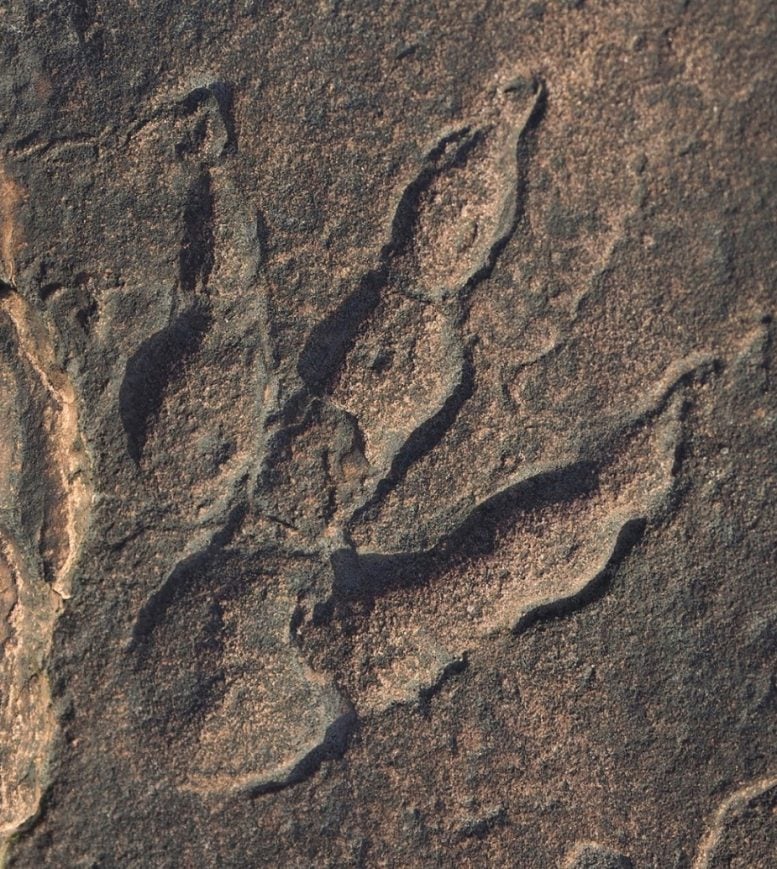A major fossil discovery in Wales reveals early dinosaurs that lived on a tropical lowland by the sea more than 200 million years ago. The study identified rare marine and terrestrial fossils, reconstructed a complex ecological system and provided new insights into the evolution of dinosaurs. Artist’s rendering of the British Archipelago during the Triassic. Credit: Gabriel Ugueto, CC-BY 4.0
Recent fossil finds in Wales have revealed the tropical habitats of early dinosaurs and provided insight into a complex prehistoric ecosystem, marking a major advance in understanding the palaeontological history of the region.
A major fossil discovery has shed light on the history of dinosaurs in Wales. The Land of the Dragon had no dinosaurs until recently. However, several dinosaurs have been reported in the last ten years, but their living conditions were not well known. In a new study by the team from University of Bristol and published in Proceedings of the Association of Geologistsimportant details were revealed for the first time.
They found that the early Welsh dinosaurs from more than 200 million years ago lived on a tropical lowland by the sea. Dinosaur tracks are known from Barry and other nearby sites, indicating that dinosaurs roamed the warm plains.
Fossil discovery at Lavernock Point
The discovery was made at Lavernock Point, near Cardiff and Penarth, where cliffs of dark colored shale and limestone document ancient shallow seas. Several levels are piled with bones, including the remains of fish, sharks, marine reptiles, and the occasional dinosaur.
The study was led by former Bristol MSc palaeobiology student Owain Evans. He explained: “The bone bed paints a picture of a tropical archipelago that was exposed to frequent storms that washed material from all around, both on land and sea, into the intertidal zone. This means that from just one fossil horizon we can reconstruct a complex ecological system with a diverse array of marine reptiles such as ichthyosaurs, plesiosaurs and placodonts in the water and dinosaurs on land.

A trace found in Triassic rocks from South Wales. Credit: Cindy Howells at the National Museum of Wales
“I’ve been visiting the coast in Penarth all my life, growing up in Cardiff, but I never noticed the fossils. Then, the more I read, the more amazing it became. Local geologists have been collecting the bones since the 1870s and most of them are in the National Museum of Wales in Cardiff.
Cindy Howells, curator of palaeontology at the National Museum of Wales, adds: “The Lavernock collections go back to the 19th century.Thursday century, with many parts of the bone bed collected over the years. The presence of dinosaur fossils at the site ensures that it remains one of the most important sites for palaeontology in Wales.
Two discoveries the team made while carrying out fieldwork at Lavernock were the fossilized remains of a placodont osteoderm and one coelacanth gular bone. Lead Dr Chris Duffin said: “Coelacanth and placodont remains are relatively rare in the UK, which makes these finds even more remarkable. These two fossils alone help to paint a wider picture of what the Rhaetian would have looked like in Great Britain.
Professor Michael Benton, from Bristol’s School of Earth Sciences, another project leader, added: “The volume of dinosaur remains found at Lavernock is extremely exciting and a chance to study a complex and often mysterious period in their evolutionary history. We have identified the remains of a large Plateosaurus like an animal, along with several bones that probably belonged to a carnivorous theropod.
A significant part of the article is devoted to the abundant microfossils found at the site, which include fish teeth, scales and bone fragments. By examining thousands of specimens, the team was able to identify the key species in shallow seas and determine the relative importance of each.
The origin of Welsh dragons has finally been revealed.
Reference: “Microvertebrates from the Basal Rhaetian Bone Bed (Late Triassic) in Lavernock, South Wales” by Owain Evans, Christopher J. Duffin, Claudia Hildebrandt and Michael J. Benton, 23 May 2024, Proceedings of the Association of Geologists.
DOI: 10.1016/j.pgeola.2024.05.001